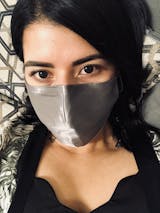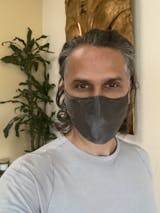Are you curious about how you can use ancient beauty tips in the modern-day world to achieve simple and effortless beauty for flawless skin?
There’s a popular shift towards natural simplicity and lifestyle refinement. More of us are seeking ancestral techniques that are in alignment with the earth’s wisdom, and that bring us closer to our spiritual earth connection.
In this article, we explore the sacred beauty tips of Ayurveda and how you can incorporate them into your modern-day skincare routine.
The Ancient Beauty Secrets Of Ayurveda
Ayurveda, also known as the ‘knowledge of life’, originates from South Asia and sacred Sanskrit texts. The practice of Ayurveda seeks to balance the ‘dosha’s’ and increase healthy longevity. You may be drawn towards the power of Ayurveda because many Ayurvedic medicines are entirely herbal, simple, and natural.
Whilst the medicinal system of Ayurveda is not specifically based solely on beauty, it just so happens that beauty is often inexplicably tied to optimal health. Living the best lifestyle you can, dependant on your own individual circumstances, simultaneously allows you to look and feel your best.
The practice of Ayurveda is often known as the sister science to yoga, as both philosophies originate from the same system of ancient Sanskrit texts. The holistic system of ayurveda aims to keep the body healthy to ensure that the yoga practitioner can effectively practice yoga to obtain spiritual liberation and energetic balance.
Ayurvedic treatments for holistic balance and wellbeing can include herbal remedies, yogic practices, breathing practices (pranayama), lifestyle adjustments, natural treatments, and meditation.
What Are The Three Ayurvedic Doshas?
The three Ayurvedic doshas are pitta, kapha, and vata. Ayurveda aims to balance the body physically and energetically which allows your natural beauty to effortlessly shine through. The Ayurveda system is based on the three doshas which each hold their own individual properties.
In accordance with Ayurveda, each individual has a ‘prakriti’, which can be understood as a unique combination of the three dosha constitutions. Your prakriti is defined at birth and cannot be changed. However due to lifestyle, a poor work and rest balance, the wrong diet, or general bad habits, this natural unique balance can be disturbed leading individuals away from optimal health, and at worst, even causing ill health.
To understand your doshas, and how to live in accordance with your prakriti and dosha, consult your local Ayurvedic doctor or Ayurvedic practitioner who will ascertain your unique constitution and prepare Ayurvedic healing recommendations for your needs.
Ayurvedic Beauty Tips For Glowing Skin
Understanding your dosha can help to easily work out your skin type and skin’s needs. When an Ayurvedic doctor is establishing your prakriti, they will use parts of your physical appearance to identify your constitution, including your skin.
Incorporating these Ayurvedic beauty tips tailored to your skin type in your beauty routine helps to encourage healthy skin that naturally radiates with beauty.
How Do I Take Care Of My Vata Skin?
If you are predominantly ‘vata dosha’ you may notice that your skin tends to be dry, flaky, rough with poor texture, and wrinkles form easily. Vata skin really benefits from thorough moisturization and warmth. Vata dosha in general is known to be dry, airy, and cold - so focus on retaining hydration and warming the skin to enhance your beautiful skin.
You can consume warming herbs and spices like ginger. But you can also add these warming herbs and spices into your beauty routine to boost the effects. UpCircle’s Cinnamon And Ginger Chai Soap Bar is perfect for the vata skin type.
The UpCircle’s Cinnamon And Ginger Chai Soap Bar contains organic cinnamon leaf oil, organic ginger root oil, nutmeg, star anise, clove, green cardamom, fennel, and allspice - which are all perfect warming spices and herbs for the vata skin type. The pink clay gently exfoliates any dry or dead skin cells, whilst the glycerin keeps dry skin properly hydrated and moisturized.
The Honua Skincare ʻŌlena Beauty Oil is great to moisturize and warm vata skin because it contains turmeric and rosemary which holds heating Ayurvedic properties. Whilst the kukui nut and kamani oil help to nourish, hydrate, and protect dry vata skin.
How Do You Calm Pitta Skin?
If you are mainly ‘pitta dosha’ predominant, your skin tends to be oily. You may experience skin that is prone to things like inflammation, acne, rashes, hyperpigmentation, and rosacea. Pitta dosha is known to be hot, and so it really benefits from cooling herbs and spices along with herbs and spices that control inflammation.
Investing in a cleanser and moisturizer that is cooling and fights irritation and inflammation is important for the pitta skin type. You can check out the Earthwise Marshmallow Face Cleanser and Earthwise Ambrosia do Cerrado Liquid Moisturizer.
The Earthwise Marshmallow Face Cleanser calms sensitive irritated skin through its unique blend of herbal ingredients. The organic marshmallow root holds anti-inflammatory and antioxidant properties which are great for irritated pitta skin, or just to keep pitta skin balanced and glowing.¹
The Earthwise Marshmallow Face Cleanser also contains organic aloe vera, organic coconut oil, and organic chamomile which are known to be cooling ingredients in Ayurveda. This means they are perfect to cool and calm pitta skin which tends to be warm and hot. Aloe vera is also great for wound healing which is perfect for damaged and irritated pitta skin.
You’ll also find the organic hemp oil in the Earthwise Marshmallow Face Cleanser is perfect for oily skin because it has a low comedogenic rating which means that it doesn’t block pores. Clinical research has shown that hemp oil holds anti-inflammatory, anti-microbial, anti-lipogenic properties as well as improving collagen function.² They found that hemp seed oil can be effectively used for acne-prone skin to help calm and soothe skin problems in order to reveal radiant skin.
The Earthwise Ambrosia do Cerrado Liquid Moisturizer also contains cooling organic aloe vera and elderberry, as well as Vitamin C (ascorbic acid). Vitamin C (ascorbic acid) is important to heal the skin from sun damage and can be used as a natural treatment for hyperpigmentation.³ It promotes collagen, balances skin tone, and stimulates the healing of skin problems from acne to general irritation.
How Do You Treat Kapha Skin?
If you are mainly ‘kapha dosha’ dominant you might find that your skin tends to be dull and retain water. You might also experience puffiness or swelling. Kapha skin is cold, but also oily, and it benefits from detoxing and cleansing. If you have kapha skin then focus on warming the skin, whilst also keeping your natural oil levels balanced. Make sure you encourage stimulation and deep cleansing. Kapha dosha is known to be cold and soft, but also heavy.
The UpCircle Organic Face Serum With Coffee Oil is great for kapha skin as coffee is great to stimulate warmth in Ayurveda. But not only that, clinical research shows that when used in cosmetics coffee also helps to increase blood circulation in the skin, which is also vital for healthy lymphatic drainage and glowing skin.⁴ So coffee helps to detox and cleanse the skin, which is perfect for puffy kapha skin types.
The UpCircle Organic Face Serum With Coffee Oil also contains organic jojoba seed oil, which is anti-inflammatory, antioxidant, and highly effective for skin barrier repair.⁵ Jojoba seed oil contains a low comedogenic rating, which makes it perfect for balancing oily kapha skin.
The UpCircle Coffee Face Scrub - Citrus Blend contains coffee (obviously) which we already know is great for the kapha skin type. But, this beautiful scrub also helps to detox dull, tired, and puffy kapha skin through exfoliation and stimulation.
Natural Ayurveda Beauty Ingredients
There are many different Ayurvedic beauty tips to choose from. Here are a few timeless Ayurvedic beauty tips for hair care and skincare.
- Olive oil is a classic Ayurvedic natural ingredient. You can easily use olive oil in your hair care by replacing your serum with this minimalist natural ingredient.
- Rose water is a staple in Ayurveda skin care, it is a great natural skincare product. You can use rose water as a toner prior to moisturizing the skin. Rose water helps to hydrate and nourish the skin, whilst your moisturizer follows to seal in the hydration.
- Coconut oil and shea butter are great for hair care and skincare. You can use coconut oil or shea butter as a hair serum, or a body moisturizer.
- Turmeric powder makes a wonderful face mask. Mix a little bit of rose water into turmeric powder until it forms a thick paste, and you have your own complexion brightening face mask for dull and tired skin.
- Herbal tea makes a powerful rinse for damaged hair. Simply steep your chosen herbs, to create a rinse for your hair. Shampoo and condition your hair as normal, and then rinse your hair with your herbal tea.
Conclusion
Using the correct Ayurvedic ingredients for your skin type is a simple way to achieve glowing skin. You can easily choose your own natural ingredients to make your own tailored skin care routine, or you can invest in natural sustainable skin care products that are especially formulated to encourage healthy skin.
Carmen Lee is a certified yoga teacher, childbirth doula, and wellness coach. She educates on womb wellness, sacred wisdom, and ancestral-connected living. You’ll find her passionately advocating radical self-care and transformational self-empowerment through sustainable beauty and self-love rituals.
Some of the products promoted in our blog are from our online store. Many others are brands we have researched and found to be great examples of sustainable, ethical, and innovative brands in their field, and we don't make any profit from mentioning them in our blog. #CollaborationOverCompetition
- https://www.ncbi.nlm.nih.gov/pmc/articles/PMC7090173/
- https://www.ncbi.nlm.nih.gov/pmc/articles/PMC6110517/
- https://www.ncbi.nlm.nih.gov/pmc/articles/PMC3673383/
- https://pubmed.ncbi.nlm.nih.gov/23075568/
- https://www.ncbi.nlm.nih.gov/pmc/articles/PMC5796020/










